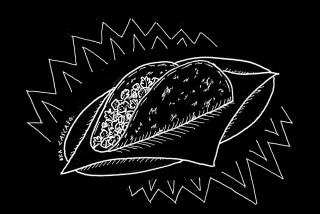Cartoonist created popular Latino comic strip ‘Gordo’
- Share via
Gustavo Arriola, a cartoonist who created “Gordo,” a pioneering comic strip that celebrated Latino culture and traditions, has died. He was 90.
Arriola died Saturday of complications from cancer and Parkinson’s disease at his home in Carmel, said his wife Mary Frances.
Known as “Gus,” Arriola launched his cartoon in 1941 featuring Gordo Lopez, a Mexican bean farmer, as the main character. By the late 1940s “Gordo” was published seven days a week, a schedule that continued until the last cartoon appeared in March 1985.
At the height of its popularity in the 1960s, “Gordo” appeared in 270 newspapers, historian Robert C. Harvey said.
It was “the most visible ethnic comic strip in America and its creator the most visible American of Mexican descent working as a syndicated cartoonist,” said Harvey, coauthor with Arriola of “Accidental Ambassador Gordo,” published in 2000.
Originally, the character was a fat, lazy bumpkin who spoke with a thick accent.
After Arriola’s readers complained about the stereotype, the cartoonist transformed Gordo into a slimmed-down tour guide who drove a rickety bus named for Halley’s Comet, a hint at how rarely the vehicle actually came around.
Gordo lived in rural Mexico, dressed in sombreros and a charro outfit. His companions included a menagerie of farm animals including Senor Dog. Eventually Gordo married his housekeeper, Tehuana Mama.
Donkeys, cactus, clay pots and other bits from rural life dotted the scenery.
When “Gordo” premiered, “it was the only nationally distributed comic strip with a Mexican milieu,” Harvey said. Later, when the bean farmer became a tour guide, Harvey said, “There was nothing like ‘Gordo’ on the planet.”
The strip was known for its gentle humor and a story that followed Gordo’s romantic adventures, his bickering with his nephew Pepito, and other events from his daily life that made him a Latino Everyman.
Arriola’s Sunday cartoon included frames that stood alone as abstract artworks.
“The Sunday strip was a stunning composition with lively line work and dazzling colors,” said Malcolm Whyte, founder of the Cartoon Art Museum in San Francisco. Arriola evoked Mexican cut-paper designs in some of his drawings. He used Latino festivals and folklore in some strips and often returned to ecological themes that related to rural Mexico.
Arriola was born July 23, 1917, in Florence, Ariz., the youngest of nine children. His father was a native of Sonora, Mexico, who moved to the United States in the 1980s. His mother was born in California.
When Arriola was 8, the family relocated to Los Angeles. He graduated from Manual Arts High School, where he received his formal art training.
After graduation Arriola got a job in animation at the Charles Mintz Studio in Los Angeles.
He next went to the cartoon studio at Metro-Goldwyn-Mayer in 1937. He became an assistant animator and worked on the popular “Tom & Jerry” cartoons.
Arriola met artist Mary Frances Sevier at MGM. They married in 1943 and had one son, Carlin, who inspired the character of Pepito, Gordo’s nephew, in the comic strip.
Carlin Arriola died in 1980, at age 35, of injuries suffered in an automobile accident. In addition to his wife, Arriola is survived by a grandchild and two great-grandchildren.
One year after the United Feature agency began syndicating “Gordo,” Arriola joined the U.S. Army Air Forces, serving in a motion picture unit during World War II.
He launched his Sunday cartoon while he was in the service and resumed his weekday comic strip after being discharged in 1946.
For the first 20 years of “Gordo,” Arriola relied on books, articles and photographs about Mexico. Finally, he visited the country for the first time in 1960.
From then on, he told Harvey, “I tried to work it all into the strip. The history, the culture, the folk art, as seen through Gordo’s eyes.”
--


